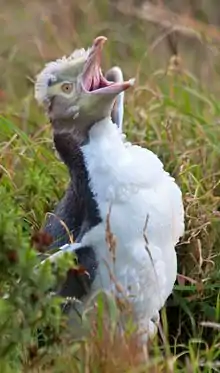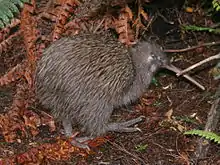Yellow-eyed penguin
The yellow-eyed penguin (Megadyptes antipodes), known also as hoiho or tarakaka, is a species of penguin endemic to New Zealand.[2][3]
| Yellow-eyed penguin | |
|---|---|
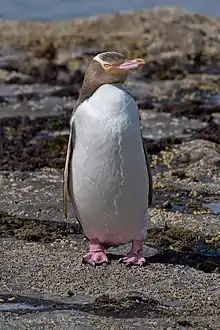 | |
| In the Curio Bay of Southland District, New Zealand | |
| Scientific classification | |
| Kingdom: | Animalia |
| Phylum: | Chordata |
| Class: | Aves |
| Order: | Sphenisciformes |
| Family: | Spheniscidae |
| Genus: | Megadyptes |
| Species: | M. antipodes |
| Binomial name | |
| Megadyptes antipodes | |
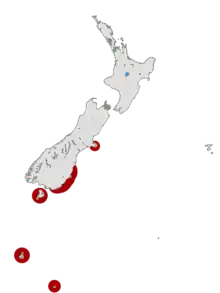 | |
| Distribution of Yellow-eyed penguin | |
Previously thought closely related to the little penguin (Eudyptula minor), molecular research has shown it more closely related to penguins of the genus Eudyptes. Like most other penguins, it is mainly piscivorous.
The species breeds along the eastern and south-eastern coastlines of the South Island of New Zealand, as well as Stewart Island, Auckland Islands, and Campbell Islands. Colonies on the Otago Peninsula are a popular tourist venue, where visitors may closely observe penguins from hides, trenches, or tunnels.
On the New Zealand mainland, the species has experienced a significant decline over the past 20 years. On the Otago Peninsula, numbers have dropped by 75% since the mid-1990s and population trends indicate the possibility of local extinction in the next 20 to 40 years. While the effect of rising ocean temperatures is still being studied, an infectious outbreak in the mid 2000s played a large role in the drop. Human activities at sea (fisheries, pollution) may have an equal if not greater influence on the species' downward trend.[4]
Taxonomy
The yellow-eyed penguin was first described by Jacques Bernard Hombron and Honoré Jacquinot in 1841.
Until recently, it was assumed yellow-eyed penguins were widespread and abundant before the arrival of Polynesian settlers in New Zealand. However, genetic analysis has since revealed its range expanded to include mainland New Zealand in the past 200 years.[5][6]
The yellow-eyed penguin is the sole extant species in the genus Megadyptes. A smaller, recently extinct species, M. waitaha, was discovered in 2008. The remains of a recently extinct dwarf subspecies, M. a. richdalei, were described from the Chatham Islands in 2019.[7]
It was previously thought closely related to the little penguin but new molecular research has shown it more closely related to penguins of the genus Eudyptes. Mitochondrial and nuclear DNA evidence suggests it split from the ancestors of Eudyptes around 15 million years ago. In 2019 the 1.25Gb genome of the species was published as part of the Penguin Genome Consortium,[8][9] and this will help resolve the origins and aid conservation by helping to inform any future breeding programs.
Description
Appearance
The yellow-eyed penguin is most easily identified by the band of pale yellow feathers surrounding its eyes and encircling the back of its head.[10] Its forehead, crown and the sides of its face are slate grey flecked with golden yellow.[11] Its eye is yellow.[2][10] The foreneck and sides of the head are light brown.[2] The back and tail are slate blue-black.[2][11] Its chest, stomach, thighs and the underside of its flippers are white in colour.[2]
It is the largest living penguin to breed on the mainland of New Zealand.[2] It stands 62–79 centimetres (24–31 in) tall and weighs 3–8.5 kilograms (6.6–18.7 lb).[2][12] Weight varies throughout the year, with penguins being heaviest just before moulting, during which they may lose 3-4 kilograms in weight.[13] Males (5.5 kg) are heavier than females (5.25 kg).[12][14]
Juvenile birds have a greyer head with no yellow band around their eyes.[10]
The yellow-eyed penguin may be long lived, with some individuals reaching 20 years of age. Males are generally longer lived than females, leading to a sex ratio of 2:1 around the age of 10–12 years.[15]
Distribution and habitat
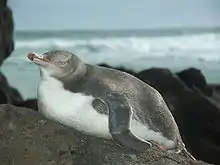
Range
Hoiho are found in two distinct populations, known as the northern and southern populations.[16]
The northern population extends along the southeast coast of the South Island of New Zealand, down to Stewart Island and Codfish Island.[2] It includes four main breeding areas in Banks Peninsula, North Otago, Otago Peninsula and the Catlins. It may also be referred to as the mainland population.[3]
The southern population includes the Subantarctic Auckland Islands and Campbell Island.[16]
There is little gene flow between the northern and southern populations as the large stretch of ocean between the South Island and Subantarctic region and the subtropical convergence act as a natural barrier.[17]
Behaviour
Feeding
Around 90% of the yellow-eyed penguin's diet is made up of fish, chiefly demersal species that live near the seafloor (e.g. blue cod (Parapercis colias), red cod (Pseudophycis bachus), opalfish (Hemerocoetes monopterygius) [18]). Other species taken are New Zealand blueback sprat (Sprattus antipodum) and cephalopods such as arrow squid (Nototodarus sloanii). Recently, jellyfish were found to be targeted by the penguins. While initially thought that the birds would prey on jellyfish itself [19] deployments of camera loggers revealed that the penguins were going after juvenile fish and fish larvae associated with jellyfish.[20]
Breeding penguins usually undertake two kinds of foraging trips: day trips where the birds leave at dawn and return in the evening ranging up to 25 km from their colonies, and shorter evening trips during which the birds are seldom away from their nest longer than four hours or range farther than 7 km.[21] Yellow-eyed penguins are known to be an almost exclusive benthic forager that searches for prey along the seafloor. Accordingly, up to 90% of their dives are benthic dives.[21] This also means that their average dive depths are determined by the water depths within their home ranges.[22]
Breeding
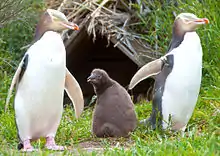
Whether yellow-eyed penguins are colonial nesters has been an ongoing issue with zoologists in New Zealand. Most Antarctic penguin species nest in large high density aggregations of birds. For an example see the photo of nesting emperor penguin. In contrast yellow-eyed penguins do not nest within visual sight of each other. While they can be seen coming ashore in groups of four to six or more individuals then disperse along track to individual nests sites out of sight of each other. The consensus view of New Zealand penguin workers is that it is preferable to use habitat rather than colony to refer to areas where yellow-eyed penguins nest. Nest sites are selected in August and normally two eggs are laid in September. The incubation duties (lasting 39–51 days) are shared by both parents who may spend several days on the nest at a time. For the first six weeks after hatching, the chicks are guarded during the day by one parent while the other is at sea feeding. The foraging adult returns at least daily to feed the chicks and relieve the partner.
After the chicks are six weeks of age, both parents go to sea to supply food to their rapidly growing offspring. Chicks usually fledge in mid-February and are totally independent from then on. Chick fledge weights are generally between 5 and 6 kg.
First breeding occurs at three to four years of age and long-term partnerships are formed.
Conservation
The yellow-eyed penguin is considered one of the rarest penguin species in the world.[23] It is listed on the IUCN Red List as being endangered. It was first included on the list in 1988 when it was listed as threatened. Its status has since been changed to endangered in the year 2000.[24]
It has an estimated population of 4000. The main threats include habitat degradation and introduced predators. It may be the most ancient of all living penguins.[25]
A reserve protecting more than 10% of the mainland population was established at Long Point in the Catlins in November 2007 by the Department of Conservation and the Yellow-eyed Penguin Trust.[26][27]
In August 2010, the yellow-eyed penguin was granted protection under the U.S. Endangered Species Act.[28]
Disease

In spring 2004, a previously undescribed disease killed off 60% of yellow-eyed penguin chicks on the Otago peninsula and in North Otago. The disease has been linked to an infection of Corynebacterium, a genus of bacteria that also causes diphtheria in humans. It has recently been described as diphtheritic stomatitis. However, it seems as if this is just a secondary infection. The primary pathogen remains unknown. A similar problem has affected the Stewart Island population.[29]
Tourism
Several mainland habitats have hides and are relatively accessible for those wishing to watch the birds come ashore. These include beaches at Oamaru, the Moeraki lighthouse, a number of beaches near Dunedin, and the Catlins. In addition, commercial tourist operations on Otago Peninsula also provide hides to view yellow-eyed penguins. However, the yellow-eyed penguin cannot be found in zoos because it will not reproduce in captivity.[30]
In culture
- The hoiho appears on the reverse side of the New Zealand five-dollar note.[31]
- The yellow-eyed penguin is the mascot to Dunedin City Council's recycling and solid waste management campaign.[32]
- The yellow-eyed penguin is also featured in Farce of the Penguins, in which they complain about global warming.
- In 2019 the yellow-eyed penguin was crowned the Bird of the Year in New Zealand, the first win for a seabird in the competition's 14-year history.[33]
References
- BirdLife International (2012). "Megadyptes antipodes". IUCN Red List of Threatened Species. 2012. Retrieved 26 November 2013.CS1 maint: ref=harv (link)
- "Yellow-eyed penguin | New Zealand Birds Online". www.nzbirdsonline.org.nz. Retrieved 27 September 2019.
- "Yellow-eyed penguin/hoiho". www.doc.govt.nz. Retrieved 29 September 2019.
- Mattern T, Meyer S, Ellenberg U, Houston DM, Darby JD, Young M, van Heezilk Y, Seddon PJ (2017). "Quantifying climate change impacts emphasises the importance of managing regional threats in the endangered Yellow-eyed penguin". PeerJ. 5: e3272. doi:10.7717/peerj.3272. PMC 5436559. PMID 28533952.
- Boessenkool, Sanne; Austin, Jeremy J; Worthy, Trevor H; Scofield, Paul; Cooper, Alan; Seddon, Philip J; Waters, Jonathan M (7 March 2009). "Relict or colonizer? Extinction and range expansion of penguins in southern New Zealand". Proceedings of the Royal Society B: Biological Sciences. 276 (1658): 815–821. doi:10.1098/rspb.2008.1246. ISSN 0962-8452. PMC 2664357. PMID 19019791.
- "Sentinels of change: prehistoric penguin species raise conservation conundrum". Sciblogs. Retrieved 29 September 2019.
- Cole, T.L.; Ksepka, D.T.; Mitchell, K.J.; Tennyson, A.J.; Thomas, D.B.; Pan, H.; Zhang, G.; Rawlence, N.J.; Wood, J.R.; Bover, P.; Bouzat, J.L. (2019). "Mitogenomes uncover extinct penguin taxa and reveal island formation as a key driver of speciation". Molecular Biology and Evolution. 36 (4): 784–797. doi:10.1093/molbev/msz017. PMID 30722030.
- Pan, Hailin; Cole, Theresa L.; Bi, Xupeng; Fang, Miaoquan; Zhou, Chengran; Yang, Zhengtao; Ksepka, Daniel T.; Hart, Tom; Bouzat, Juan L.; Argilla, Lisa S.; Bertelsen, Mads F. (1 September 2019). "High-coverage genomes to elucidate the evolution of penguins". GigaScience. 8 (9). doi:10.1093/gigascience/giz117. PMC 6904868. PMID 31531675.
- Alan, D Tennyson J.; Andrew, Reeve Hart; McKinlay Bruce; Charles-André, Bost; Chengran, Zhou; Daniel, Ksepka T.; Thompson R David; David, Houston M.; De, Zhang Xing; Emily, Kay; Miller Gary; George, Pacheco; Guojie, Zhang; Hailin, Pan; Helen, Taylor; Bouzat L Juan; Juan, Masello F.; Kathryn, Johnson; Kim, Labuschagne; Lara, Shepherd D.; Lisa, Nupen J.; Argilla S Lisa; Mads, Bertelsen F.; Ellegaard R Martin; Melanie, Young J.; Miaoquan, Fang; Mikkel-Holger, Sinding S.; M.Thomas, Gilbert P.; Boersma Dee P; et al. (2019). "Genomic". GigaDB Dataset - DOI 10.5524/102172 - Genomic data from Yellow-eyed penguin (Megadyptes antipodes antipodes). GigaScience Database. doi:10.5524/102172.
- Heather, B. D. (Barrie D.) (22 April 2015). The field guide to the birds of New Zealand. Robertson, Hugh A. (Hugh Alexander), 1957-, Onley, Derek J. (Revised and updated ed.). [Auckland] New Zealand. ISBN 9780143570929. OCLC 946520191.
- "Yellow-eyed penguin biology". Penguin Rescue. Retrieved 29 September 2019.
- Marion, Remi, Penguins: A Worldwide Guide. Sterling Publishing Co. (1999), ISBN 0-8069-4232-0
- "Moulting". Yellow-eyed Penguin Trust. Retrieved 29 September 2019.
- Richdale, L (1957). A population study of penguins. Oxford: Oxford University Press.
- "Distribution and habitat". Yellow-eyed Penguin Trust. Retrieved 29 September 2019.
- Boessenkool, Sanne; Star, Bastiaan; Waters, Jonathan M.; Seddon, Philip J. (June 2009). "Multilocus assignment analyses reveal multiple units and rare migration events in the recently expanded yellow-eyed penguin ( Megadyptes antipodes )". Molecular Ecology. 18 (11): 2390–2400. doi:10.1111/j.1365-294X.2009.04203.x. PMID 19457203. S2CID 205361804.
- Moore, P.J.; Wakelin, M.D. 1997: Diet of the yellow-eyed penguin Megadyptes antipodes, South Island, New Zealand, 1991-1993. Marine Ornithology 25:17-29
- Thiebot, Jean-Baptiste; Arnould, John PY; Gómez-Laich, Agustina; Ito, Kentaro; Kato, Akiko; Mattern, Thomas; Mitamura, Hiromichi; Noda, Takuji; Poupart, Timothée; Quintana, Flavio; Raclot, Thierry (2017). "Jellyfish and other gelata as food for four penguin species - insights from predator-borne videos". Frontiers in Ecology and the Environment. 15 (8): 437–441. doi:10.1002/fee.1529.
- Mattern, Thomas; Ellenberg, Ursula; Heezik, Yolanda Van; Seddon, Philip J (2017). "Penguins hunting jellyfish: main course, side dish or decoration?". doi:10.13140/RG.2.2.22929.33123. Cite journal requires
|journal=(help) - Mattern, T.; Ellenberg, U.; Houston, D.M.; Davis, L.S. 2007: Consistent foraging routes and benthic foraging behaviour in yellow-eyed penguins. Marine Ecology Progress Series 343: 295-306
- Mattern, T.; Ellenberg, U.; Houston, D.M.; Lamare, M.; van Heezik, Y.; Seddon, P.J., Davis, L.S. 2013: The Pros and Cons of being a benthic forager: How anthropogenic alterations of the seafloor affect Yellow-eyed penguis. Keynote presentation. 8th International Penguin Conference, Bristol, UK. 2–6 September 2013. https://web.archive.org/web/20131111100029/http://combine.cs.bris.ac.uk/opencms/ipc/materials/IPC8_Abstract_Book_complete.pdf
- "Population and recent trends". Yellow-eyed Penguin Trust. Retrieved 29 September 2019.
- "The IUCN Red List of Threatened Species". IUCN Red List of Threatened Species. Retrieved 29 September 2019.
- Other Penguin Species. Yellow-eyed Penguin Trust. Accessed 28 November 2007.
- Gwyneth Hyndman, Land set aside for yellow-eyed penguin protection in Catlins. The Southland Times, Wednesday, 28 November 2007.
- 12km coastal reserve declared for yellow-eyed penguins, Radio New Zealand News, 27 November 2007.
- Five Penguins Win U.S. Endangered Species Act Protection Turtle Island Restoration Network
- Kerrie Waterworth, Mystery illness strikes penguins, Sunday Star Times, 25 November 2007.
- "Yellow-eyed Penguins". Penguin Pedia. Retrieved 8 July 2019.
- "$5 - Reserve Bank of New Zealand". www.rbnz.govt.nz. Retrieved 29 September 2019.
- "Rubbish and Recycling - Services". Dunedin City Council. Retrieved 14 March 2011.
- "Bird of the year: Hoiho takes the title". The New Zealand Herald. 10 November 2019. ISSN 1170-0777. Retrieved 17 November 2019.
External links
| Wikispecies has information related to Megadyptes antipodes. |
| Wikimedia Commons has media related to Megadyptes antipodes. |
- State of Penguins: Yellow-eyed penguin – detailed and current species account of (Megadyptes antipodes)
- BBC Science and nature page about Megadyptes waitaha
- Official Yellow-eyed Penguin Trust site in New Zealand
- Yellow-eyed penguin on PenguinWorld
- Yellow-eyed penguin facts at Penguins in New Zealand
- penguinpage.net - Research blog about a project investigating yellow-eyed penguin foraging behaviour
- Yellow-eyed penguins from the International Penguin Conservation website
- "Hoiho (Megadyptes antipodes) recovery plan 2000–2025" (PDF). Department of Conservation, Wellington, New Zealand. 2001. Retrieved 4 October 2007.
- Roscoe, R. "Yellow-eyed Penguin". Photo Volcaniaca. Retrieved 13 April 2008.

